Sustainable and Durable Performance of Pozzolanic Additions to Prevent Alkali-Silica Reaction (ASR) Promoted by Aggregates with Different Reaction Rates
Abstract
:Featured Application
Abstract
1. Introduction
- Reducing the clinker content in the blended cement, the concentration of alkali metals is lowered in the pore solution (dilution effect).
- The additional pozzolanic calcium silicate hydrates formed (for short C–S–H gel), with lower Ca/Si ratio, provides a larger amount of nucleation sites for alkali’s absorption, i.e., higher alkali binding capacity is achieved, then limiting the ASR gel production [26]. This C–S–H gel partially fill the capillary pores densifying the cement paste and the interfacial transition zone (ITZ) [27].
- The reduction of permeability and diffusivity of the mortars and concretes by densification the cement paste and ITZ enhanced by the pozzolanic reaction, lowers the external alkalis and water ingress through the capillary pores.
- Mentioned pozzolanic materials also have a great influence on the of ASR gel properties. For instance, Monteiro et al. [28] reported that gels with high CaO/Na2Oeq ratio exhibited lower swelling capacity than gels with low CaO/Na2Oeq ratio. Accordingly, silica fume and coal fly ash shrink the swelling capacity.
- Finally, Hong and Glasser reported that the presence of Al in C–S–H gel improves the alkali binding capacity [29]. Therefore, the alumina from the coal fly ash can be dissolved into the mortar or concrete pore solution and further incorporated into the C–S–H gel during the hydration of the cement and the pozzolanic reactions involved in the C–A–S–H gel formation. Nevertheless, high levels of aluminum which may be present in the pore solution could deplete the silica dissolution rate [30], due to the aluminum absorption on the silica surfaces leading to an aluminosilicate layer generation [31].
2. Materials and Methods
2.1. Materials
2.2. Chemical and Mineralogical Characterization of the Materials
2.3. Mechanical Strenth and Open Porosity
2.4. Alkali-Aggregate Reactivity Test Method (Blended Cement Mortar-Bar Method)
2.5. Microanalysis of Pozzolanic Cement Mortars
3. Results and Discussion
3.1. Mechanical Performance and Open Porosity
3.2. Alkali-Aggregate Mitigation by Pozzolanic Additions in Cement Mortars
3.3. Microanalysis of Pozzolanic Cement Mortars
4. Conclusions
Author Contributions
Funding
Acknowledgments
Conflicts of Interest
References
- European Commission, UE 2020. A New Industrial Strategy for Europe; Communication from the Commission to the European Parliament, The European Council, The Council, The European Economic, Social Committee and The Committee of the Regions; European Commission: Brussels, Belgium, 10 March 2020; Available online: https://ec.europa.eu/info/sites/info/files/communication-eu-industrial-strategy-march-2020_en.pdf (accessed on 16 October 2020).
- European Commission, UE 2019. The European Green Deal; Communication from the Commission to the European Parliament, The European Council, the Council, The European Economic, Social Committee and The Committee of the Regions; European Commission: Brussels, Belgium, 11 December 2019; Available online: https://ec.europa.eu/info/sites/info/files/european-green-deal-communication_en.pdf (accessed on 16 October 2020).
- European Commission, UE 2011. Roadmap to a Resource Efficient Europe; Communication from the Commission to The European Parliament, The Council, The European Economic and Social Committee and The Committee of the Regions; European Commission: Brussels, Belgium, 20 September 2011; Available online: https://eur-lex.europa.eu/legal-content/EN/TXT/PDF/?uri=CELEX:52011DC0571&from=EN (accessed on 7 December 2020).
- European Commission, UE 2017. The Role of Waste-to-Energy in the Circular Economy; Communication from The Commission to The European Parliament, The Council, the European Economic and Social Committee and The Committee of the Regions; European Commission: Brussels, Belgium, 26 January 2017; Available online: https://eur-lex.europa.eu/legal-content/EN/TXT/PDF/?uri=CELEX:52017DC0034&from=en (accessed on 7 December 2020).
- The European Parliament and The Council of the European Union, UE 2018. Directive (EU) 2018/2001 of the European Parliament and of the Council of 11 December 2018 on the Promotion of the Use of Energy from Renewable Sources. Available online: https://eur-lex.europa.eu/legal-content/EN/TXT/PDF/?uri=CELEX:32018L2001&from=fr (accessed on 7 December 2020).
- The European Parliament and The Council of the European Union, UE 2019. Regulation (EU) 2020/852 of the European Parliament and of the Council of 18 June 2020 on the Establishment of a Framework to Facilitate Sustainable Investment and Amending Regulation (EU) 2019/2088. Available online: https://eur-lex.europa.eu/legal-content/EN/TXT/PDF/?uri=CELEX:32020R0852&from=EN (accessed on 7 December 2020).
- Holubčík, M.; Klačková, I.; Ďurčanský, P. Pyrolysis Conversion of Polymer Wastes to Noble Fuels in Conditions of the Slovak Republic. Energies 2020, 13, 4849. [Google Scholar] [CrossRef]
- Sanjuán, M.A.; Argiz, C.; Mora, P.; Zaragoza, A. Carbon Dioxide Uptake in the Roadmap 2050 of the Spanish Cement Industry. Energies 2020, 13, 3452. [Google Scholar] [CrossRef]
- European Commission, UE 2020. Circular Economy Action Plan. For a Cleaner and More Competitive Europe #EUGreenDeal, 1st ed.; European Commission: Brussels, Belgium, 11 March 2020; pp. 1–28. Available online: https://ec.europa.eu/commission/presscorner/detail/en/ip_20_420 (accessed on 16 October 2020).
- Sanjuán, M.Á.; Menéndez, E.; Argiz; Moragues, A. Coal bottom ash research program focused to evaluate a potential Portland cement constituent. In Proceedings of the Second International Conference on Concrete Sustainability, ICCS16, Madrid, Spain, 13–15 June 2016, 1st ed.; International Centre for Numerical Methods in Engineering (CIMNE): Madrid, Spain, 2016; pp. 532–543. [Google Scholar]
- Sanjuán, M.Á.; Andrade, C.; Mora, P.; Zaragoza, A. Carbon Dioxide Uptake by Cement-Based Materials: A Spanish Case Study. Appl. Sci. 2020, 10, 339. [Google Scholar] [CrossRef] [Green Version]
- Soltangharaei, V.; Anay, R.; Hayes, N.W.; Assi, L.; Le Pape, Y.; Ma, Z.J.; Ziehl, P. Damage Mechanism Evaluation of Large-Scale Concrete Structures Affected by Alkali-Silica Reaction Using Acoustic Emission. Appl. Sci. 2018, 8, 2148. [Google Scholar] [CrossRef] [Green Version]
- Petrounias, P.; Giannakopoulou, P.P.; Rogkala, A.; Stamatis, P.M.; Lampropoulou, P.; Tsikouras, B.; Hatzipanagiotou, K. The Effect of Petrographic Characteristics and Physico-Mechanical Properties of Aggregates on the Quality of Concrete. Minerals 2018, 8, 577. [Google Scholar] [CrossRef] [Green Version]
- Menéndez, E. Comprehensive Strategy for the Prevention of the Alkali-Silica Reaction. 2019. Available online: https://digital.csic.es/handle/10261/211145 (accessed on 16 October 2020). (In Spanish).
- Shin, J.-H.; Struble, L.J.; Kirkpatrick, R.J. Microstructural Changes Due to Alkali-Silica Reaction during Standard Mortar Test. Materials 2015, 8, 8292–8303. [Google Scholar] [CrossRef] [Green Version]
- Sáez del Bosque, I.F.; Van den Heede, P.; De Belie, N.; Sanchez de Rojas, M.I.; Medina, C. Carbonation of concrete with construction and demolition waste based recycled aggregates and cement with recycled content. Constr. Build. Mater. 2020, 234, 117336. [Google Scholar] [CrossRef]
- Barreto Santos, M.; De Brito, J.; Santos Silva, A. A Review on Alkali-Silica Reaction Evolution in Recycled Aggregate Concrete. Materials 2020, 13, 2625. [Google Scholar] [CrossRef]
- Joseph, A.M.; Van den Heede, P.; Snellings, R.; Van Brecht, A.; Grünewald, S.; Matthys, S.; De Belie, N. Preliminary Investigation on the effect of cement replacement by residues from the incineration of non-hazardous waste on strength and Alkali Silica reaction. In Proceedings of the 14th International Conference on Durability of Building Materials and Components (XIV DBMC) (Vol. PRO 107), Ghent University, Gent, Belgium, 29–31 May 2017; De Schutter, G., De Belie, N., Janssens, A., Van Den Bossche, N., Eds.; RILEM Publications S.A.R.L.: Paris, France, 2017. Available online: http://hdl.handle.net/1854/LU-8552394 (accessed on 16 October 2020).
- Argiz, C.; Menéndez, E.; Sanjuán, M.A.; Moragues, A. Alkali-silica resistance of coal bottom ash mortars. In ICCS16 Concrete Sustainability, Proceedings of the Second International Conference on Concrete Sustainability, ICCS16, Madrid, Spain, 13–15 June 2016; Gálvez, J.C., Ed.; International Center for Numerical Methods in Engineering (CIMNE): Barcelona, Spain, 2016; pp. 350–360. [Google Scholar]
- Chen, X.; Zhou, S.; Zhang, H.; Hui, Y. Alkali silicate reaction of cement mortar with cattle manure ash. Constr. Build. Mater. 2019, 203, 722–733. [Google Scholar] [CrossRef]
- Abbas, S.; Kazmi, S.M.S.; Munir, M.J. Potential of rice husk ash for mitigating the alkali-silica reaction in mortar bars incorporating reactive aggregates. Constr. Build. Mater. 2017, 132, 61–70. [Google Scholar] [CrossRef]
- Wang, H.; Wu, D.; Mei, Z. Effect of fly ash and limestone powder on inhibiting alkali aggregate reaction of concrete. Constr. Build. Mater. 2019, 210, 620–626. [Google Scholar] [CrossRef]
- Yazıcı, H.; Beglarigale, A.; Felekoğlu, K.T.; Türkel, S. Comparing the alkali-silica reaction mitigation potential of admixtures by using different accelerated test methods. Constr. Build. Mater. 2019, 197, 597–614. [Google Scholar] [CrossRef]
- Chen, H.; Soles, J.A.; Malhotra, V.M. Investigations of supplementary cementing materials for reducing alkali-aggregate reactions. Cem. Concr. Compos. 1993, 15, 75–84. [Google Scholar] [CrossRef]
- Thomas, M.D.A. The effect of supplementary cementing materials on alkali– silica reaction: A review. Cem. Concr. Res. 2011, 41, 1224–1231. [Google Scholar] [CrossRef]
- Aquino, W.; Lange, D.A.; Olek, J. The influence of metakaolin and silica fume on the chemistry of alkali-silica reaction products. Cem. Concr. Compos. 2001, 23, 485–493. [Google Scholar] [CrossRef]
- Shehata, M.H.; Thomas, M.D.A. Use of ternary blends containing silica fume and fly ash to suppress expansion due to alkali-silica reaction in concrete. Cem. Concr. Res. 2002, 32, 341–349. [Google Scholar] [CrossRef]
- Monteiro, P.J.M.; Wang, K.; Sposito, G.; dos Santos, M.C.; de Andrade, W.P. Influence of mineral admixtures on the alkali-aggregate reaction. Cem. Concr. Res. 1997, 27, 1899–1909. [Google Scholar] [CrossRef]
- Hong, S.Y.; Glasser, F.P. Alkali sorption by C–S–H and C–A–S–H gels: Part II. Role of alumina. Cem. Concr. Res. 2002, 32, 1101–1111. [Google Scholar] [CrossRef]
- Bickmore, B.R.; Nagy, K.L.; Gray, A.K.; Brinkerhoff, A.R. The effect of Al(OH)4− on the dissolution rate of quartz. Geochim. Cosmochim. Acta 2006, 70, 290–305. [Google Scholar] [CrossRef]
- Sang, J.C.; Jakubic, R.F.; Barkatt, A.; Saad, E.E. The interaction of solutes with silicate glass and its effect on dissolution rates. J. Non-Cryst. Solids 1994, 167, 158–171. [Google Scholar] [CrossRef]
- European Committee for Standardization (CEN). EN 197-1:2011. Cement—Part. 1: Composition, Specifications and Conformity Criteria for Common Cement; European Committee for Standardization (CEN): Brussels, Belgium, 2011. [Google Scholar]
- Spanish Association for Standardization (UNE). UNE 146508:2018. Test. for Aggregates. Determination of the Alkali-Silica and Alkali-Silicate Potential Reactivity of Aggregates. Accelerated Mortar Bar Test.; Spanish Association for Standardization (UNE): Madrid, Spain, 2018. [Google Scholar]
- European Committee for Standardization (CEN). EN 196-2:2014. Method of Testing Cement—Part. 2: Chemical Analysis of Cement; European Committee for Standardization (CEN): Brussels, Belgium, 2014. [Google Scholar]
- Menéndez, E.; García-Rovés, R.; Ruiz, S. Alkali release from aggregates: Contribution to ASR. Proc. Inst. Civ. Eng. Civ. Eng. Construc. Mater. 2016, 169, 206–214. [Google Scholar] [CrossRef]
- Spanish Association for Standardization (UNE). EN 196-1:2016. Methods of Testing Cement—Part. 1: Determination of Strength; Spanish Association for Standardization (UNE): Madrid, Spain, 2016. [Google Scholar]
- Spanish Association for Standardization (UNE). UNE 83980:2014. Concrete Durability. Test. Methods. Determination of the Water Absorption, Density and Accessible Porosity for Water in Concrete; Spanish Association for Standardization (UNE): Madrid, Spain, 2014. [Google Scholar]
- American Society for Testing and Materials (ASTM) International. ASTM C-1260-14. Standard Test. Method for Potential Alkali Reactivity of Aggregates (Mortar-Bar Method); ASTM International: West Conshohocken, PA, USA, 2014. [Google Scholar]
- Spanish Association for Standardization (UNE). UNE 80113:2013. Test. Methods of Cements. Physical Analysis. Determination of the Autoclave Expansion; Spanish Association for Standardization (UNE): Madrid, Spain, 2013. [Google Scholar]
- Papadakis, V.G. Experimental investigation and theoretical modeling of silica fume activity in concrete. Cem. Concr. Res. 1999, 29, 79–86. [Google Scholar] [CrossRef]
- Skibsted, J.; Snellings, R. Reactivity of supplementary cementitious materials (SCMs) in cement blends. Cem. Concr. Res. 2019, 124, 105799. [Google Scholar] [CrossRef]
- Yogendran, V.; Langan, B.W.; Ward, M.A. Hydration of cement and silica fume paste. Cem. Concr. Res. 1991, 21, 691–708. [Google Scholar] [CrossRef]
- Mitchell, D.R.G.; Hinczak, I.; Day, R.A. Interaction of silica fume with calcium hydroxide solutions and hydrated cement pastes. Cem. Concr. Res. 1998, 28, 1571–1584. [Google Scholar] [CrossRef]
- Sanjuán, M.A.; Argiz, C.; Gálvez, J.C.; Reyes, E. Combined effect of nano-SiO2 and nano-Fe2O3 on compressive strength, flexural strength, porosity and electrical resistivity in cement mortars. Mater. Construcc. 2018, 68, e150. [Google Scholar] [CrossRef]
- Sanjuán, M.A.; Argiz, C.; Gálvez, J.C.; Moragues, A. Effect of silica fume fineness on the improvement of Portland cement strength performance. Constr. Build. Mater. 2015, 96, 55–64. [Google Scholar] [CrossRef]
- Huang, C.L.; Feldman, R.F. Hydration reactions in Portland cement–silica fume blends. Cem. Concr. Res. 1985, 15, 585–592. [Google Scholar] [CrossRef]
- Marzouk, H.; Langdon, S. The effect of alkali-aggregate reactivity on the mechanical properties of high and normal strength concrete. Cem. Concr. Compos. 2003, 25, 549–556. [Google Scholar] [CrossRef]
- Giaccio, G.; Zerbino, R.; Ponce, J.M.; Batic, O.R. Mechanical behavior of concretes damaged by alkali-silica reaction. Cem. Concr. Res. 2008, 38, 993–1004. [Google Scholar] [CrossRef]
- Sanchez, L.F.M.; Fournier, B.; Jolin, M.; Bastien, J. Evaluation of the stiffness damage test (SDT) as a tool for assessing damage in concrete due to ASR: Test loading and output responses for concretes incorporating fine or coarse reactive aggregates. Cem. Concr. Res. 2014, 56, 213–229. [Google Scholar] [CrossRef]
- Bektas, F.; Wang, K. Performance of ground clay brick in ASR-affected concrete: Effects on expansion, mechanical properties and ASR gel chemistry. Cem. Concr. Compos. 2012, 34, 273–278. [Google Scholar] [CrossRef]
- Yurtdas, I.; Chen, D.; Hu, D.W.; Shao, J.F. Influence of alkali silica reaction (ASR) on mechanical properties of mortar. Constr. Build. Mater. 2013, 47, 165–174. [Google Scholar] [CrossRef]
- Haruehansapong, S.; Pulngern, T.; Chucheepsakul, S. Effect of the particle size of nanosilica on the compressive strength and the optimum replacement content of cement mortar containing nano-SiO2. Constr. Build. Mater. 2014, 50, 471–477. [Google Scholar] [CrossRef]
- Kong, D.; Du, X.; Wei, X.; Zhang, H.; Yang, Y.; Shah, S.P. Influence of nano-silica agglomeration on microstructure and properties of the hardened cement-based materials. Constr. Build. Mater. 2012, 37, 707–715. [Google Scholar] [CrossRef]
- Tashima, M.M.; Soriano, L.; Monzó, J.; Borrachero, M.V.; Akasaki, J.L.; Payá, J. New method to assess the pozzolanic reactivity of mineral admixtures by means of pH and electrical conductivity measurements in lime:pozzolan suspensions. Mater. Construcc. 2014, 64, e032. [Google Scholar] [CrossRef] [Green Version]
- Bérubé, A.; Duchesne, J. Does silica fume merely postpone expansion due to alkali-aggregate reactivity? Constr. Build. Mater. 1993, 7, 137–143. [Google Scholar] [CrossRef]
- Cheng-yi, H.; Feldman, R.F. Influence of silica fume on the microstructural development in cement mortars. Cem. Concr. Res. 1985, 15, 285–294. [Google Scholar] [CrossRef] [Green Version]
- Choi, Y.C.; Choi, S. Alkali–silica reactivity of cementitious materials using ferro-nickel slag fine aggregates produced in different cooling conditions. Constr. Build. Mater. 2015, 99, 279–287. [Google Scholar] [CrossRef]
- Chappex, T.; Scrivener, K. The Influence of Aluminium on the Dissolution of Amorphous Silica and its Relation to Alkali Silica Reaction. Cem. Concr. Res. 2012, 42, 1513–1523. [Google Scholar] [CrossRef]
- Dent Glasser, L.S.; Kataoka, N. The Chemistry of ‘Alkali-Aggregate’ Reaction. Cem. Concr. Res. 1981, 11, 1–9. [Google Scholar] [CrossRef]
- Niibori, Y.; Kunita, M.; Tochiyama, O.; Chida, T. Dissolution Rates of Amorphous Silica in Highly Alkaline Solution. J. Nucl. Sci. Technol. 2000, 37, 349–357. [Google Scholar] [CrossRef]
- Stone, W.E.E.; El Shafei, G.M.S.; Sanz, J.; Selim, S.A. Association of Soluble Aluminum Ionic Species With a Silica-gel Surface: A Solid-State NMR Study. J. Phys. Chem. 1993, 97, 10127–10132. [Google Scholar] [CrossRef]
- Sanjuán, M.A.; Estévez, E.; Argiz, C. Alkali Ion Concentration Estimations in Cement Paste Pore Solutions. Appl. Sci. 2019, 9, 992. [Google Scholar] [CrossRef] [Green Version]
- Ramlochan, T.; Thomas, M.D.A.; Hooton, R.D. The effect of pozzolans and slag on the expansion of mortars cured at elevated temperature: Part II: Microstructural and microchemical investigations. Cem. Concr. Res. 2004, 34, 1341–1356. [Google Scholar] [CrossRef]
- Ichikawa, T. Alkali–silica reaction, pessimum effects and pozzolanic effect. Cem. Concr. Res. 2009, 39, 716–726. [Google Scholar] [CrossRef]
- Bleszynski, R.F.; Thomas, M.D. Microstructural studies of alkali-silica reaction in fly ash concrete immersed in alkaline solutions. Adv. Cem. Mater. 1998, 7, 66–78. [Google Scholar] [CrossRef]
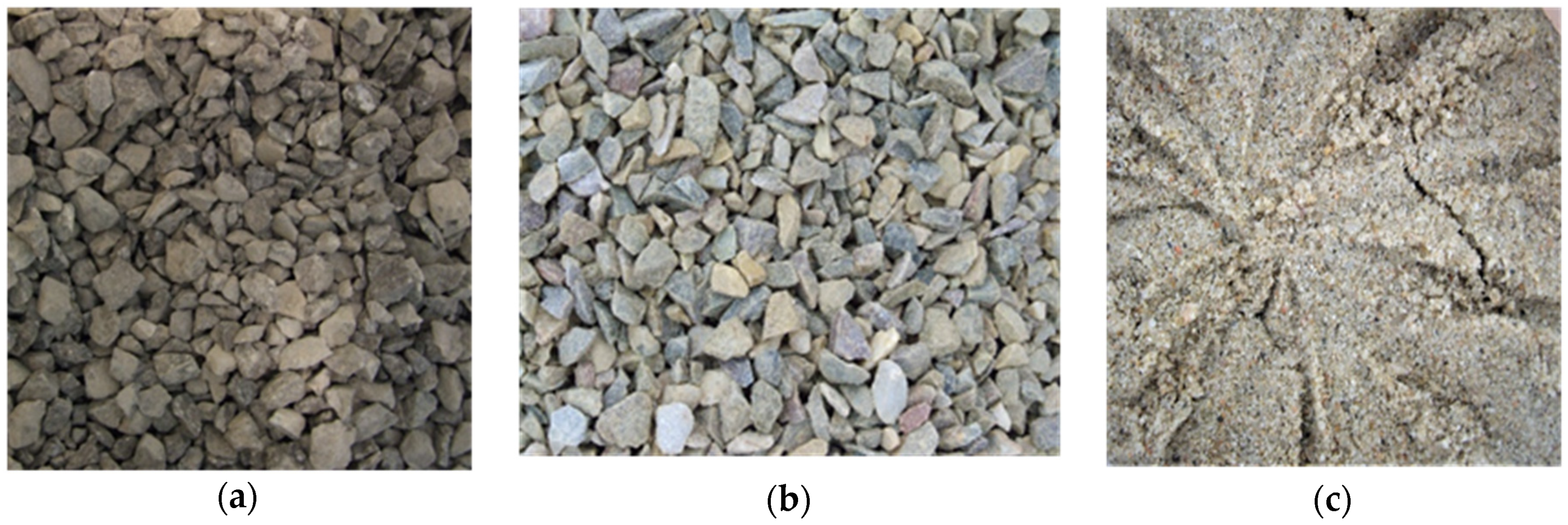

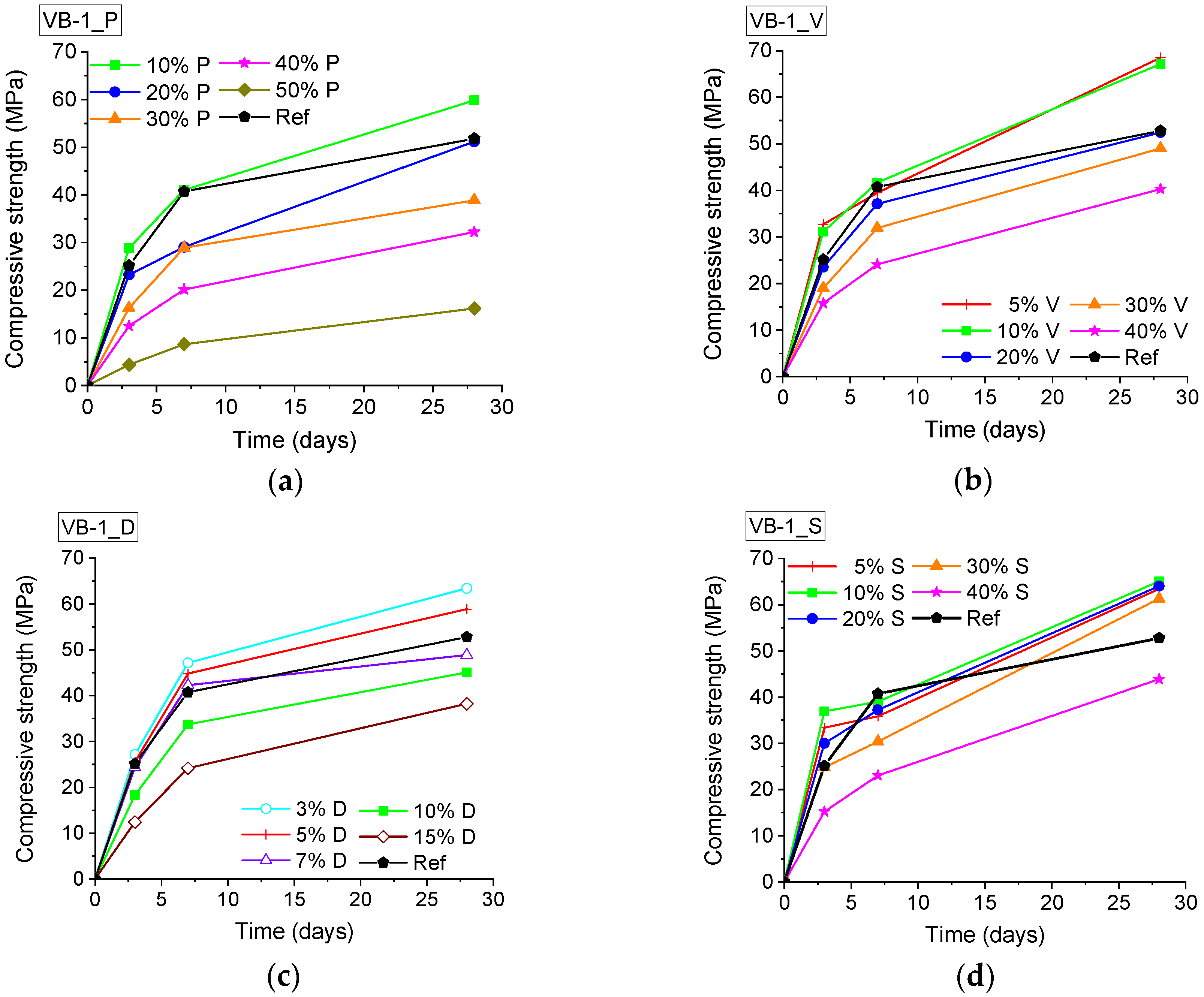
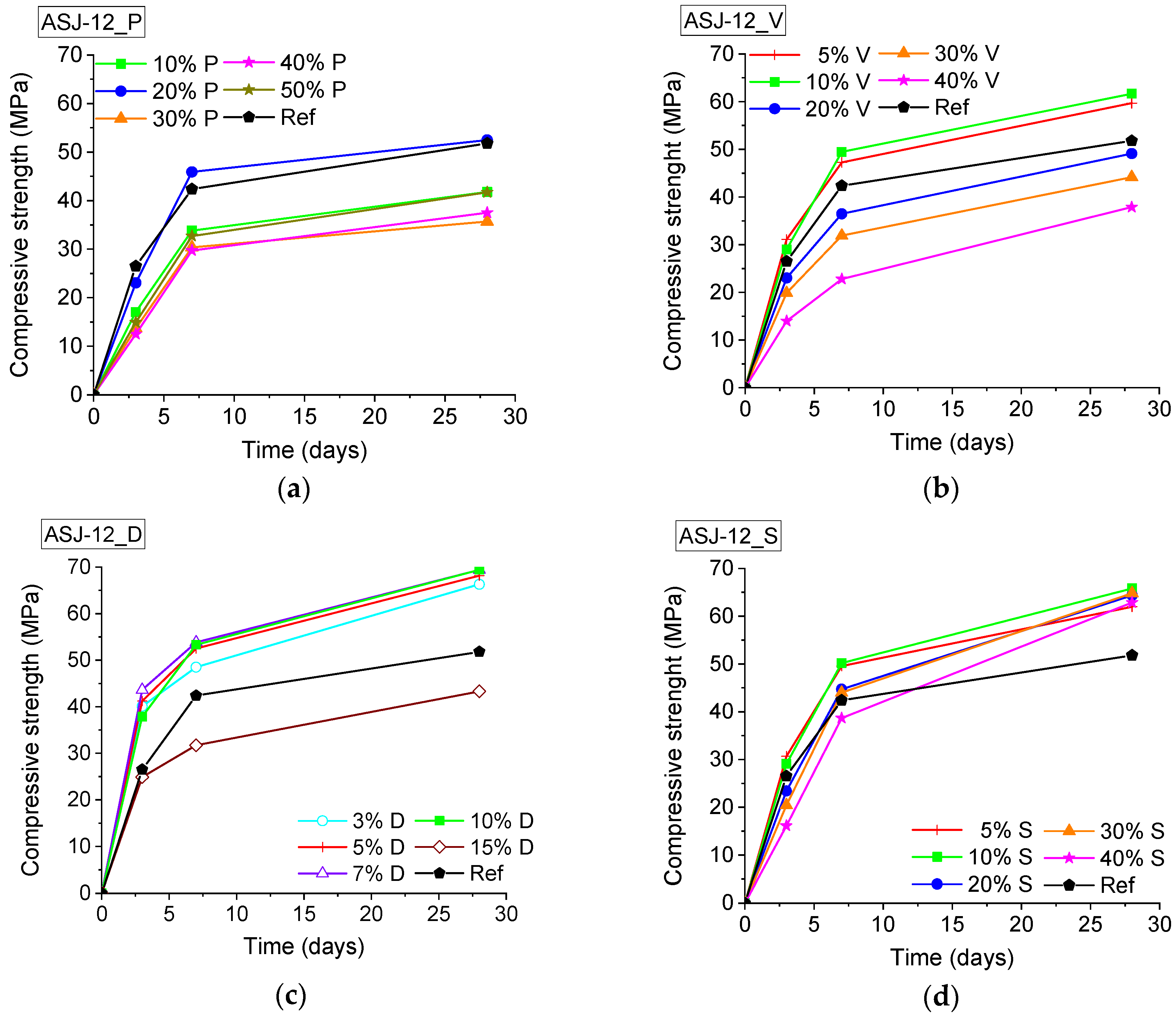

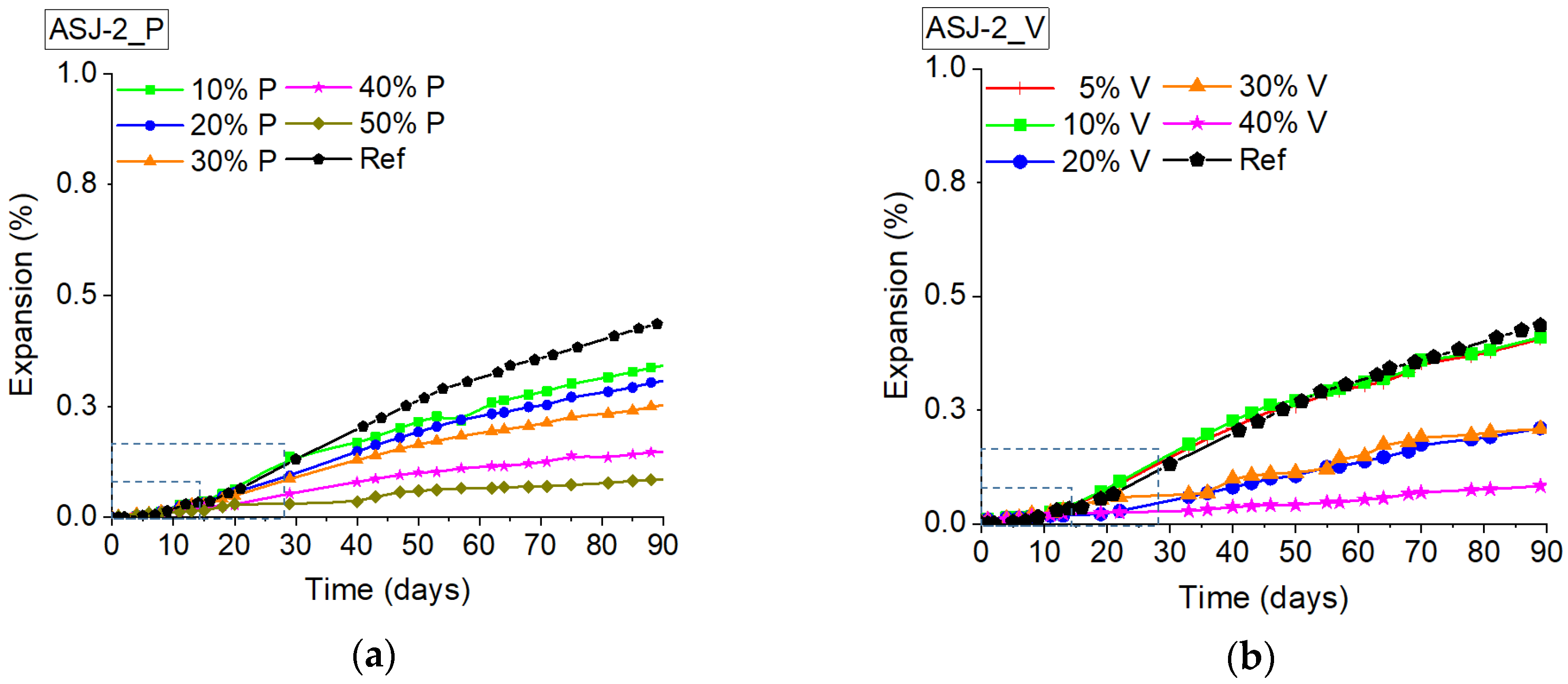
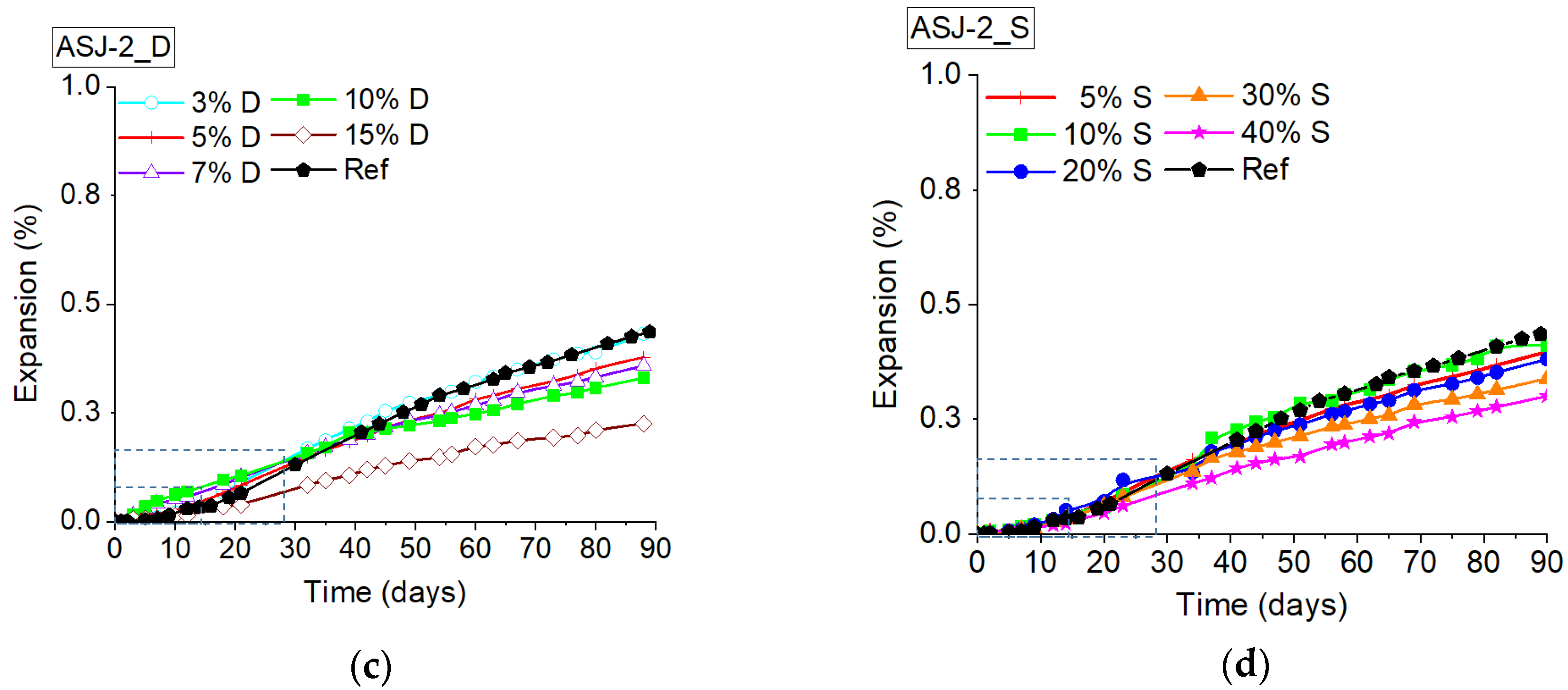



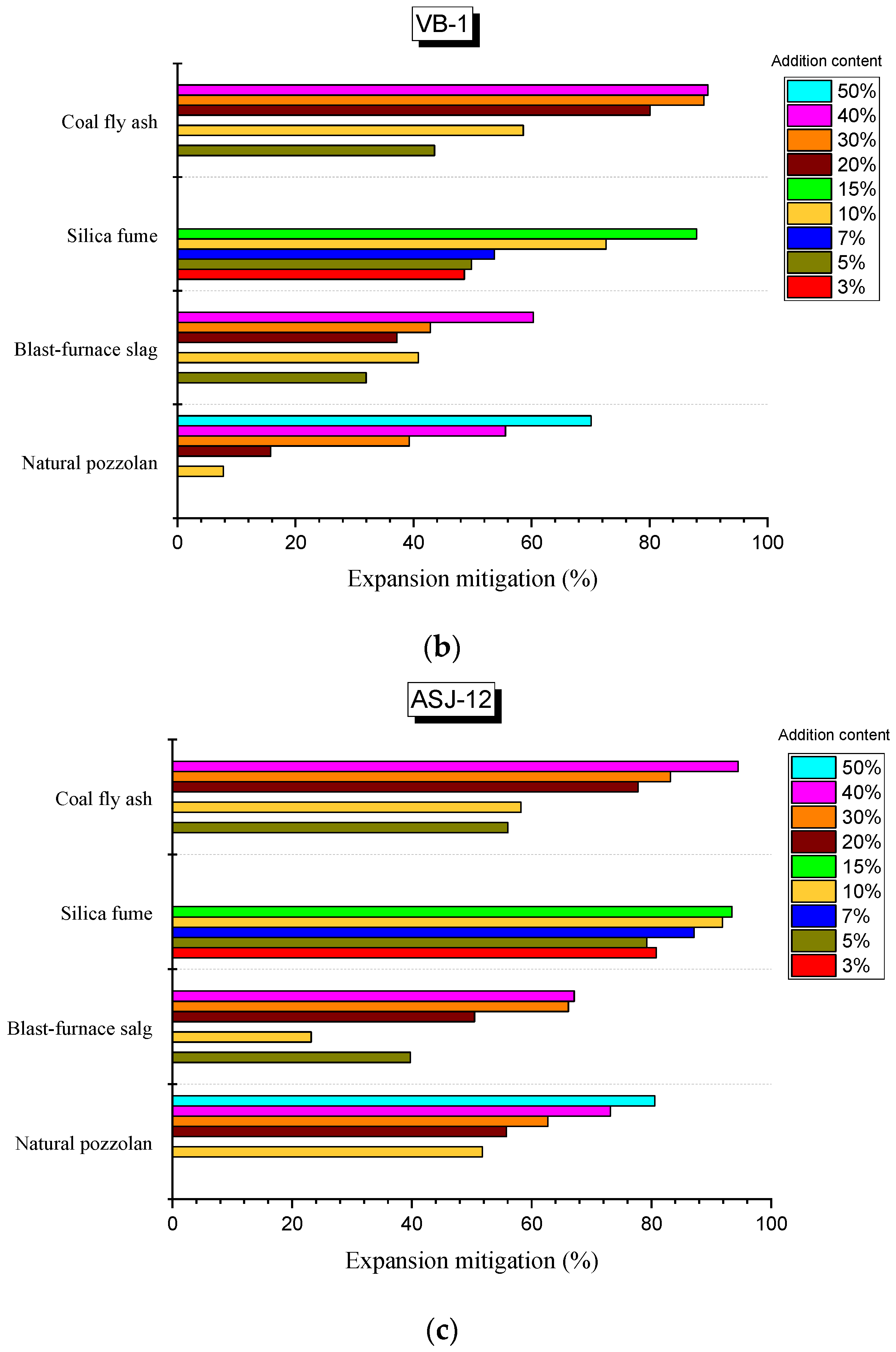

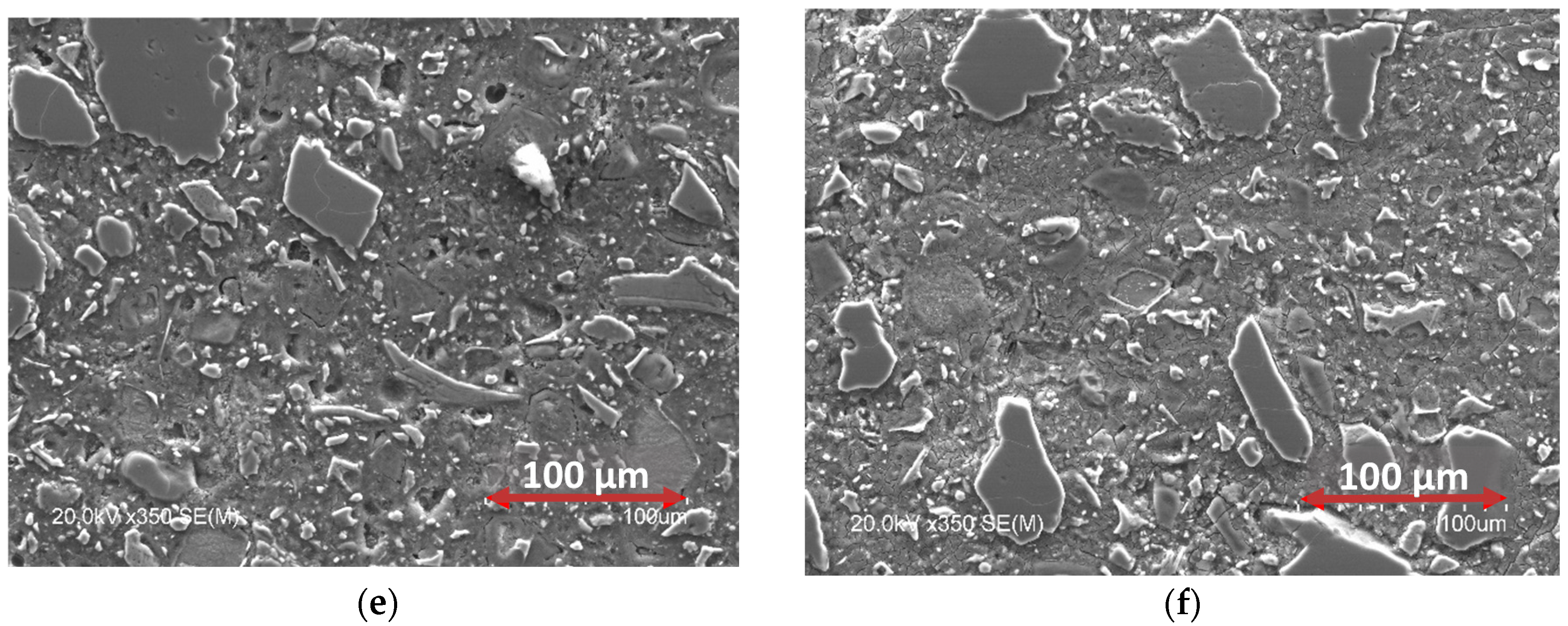
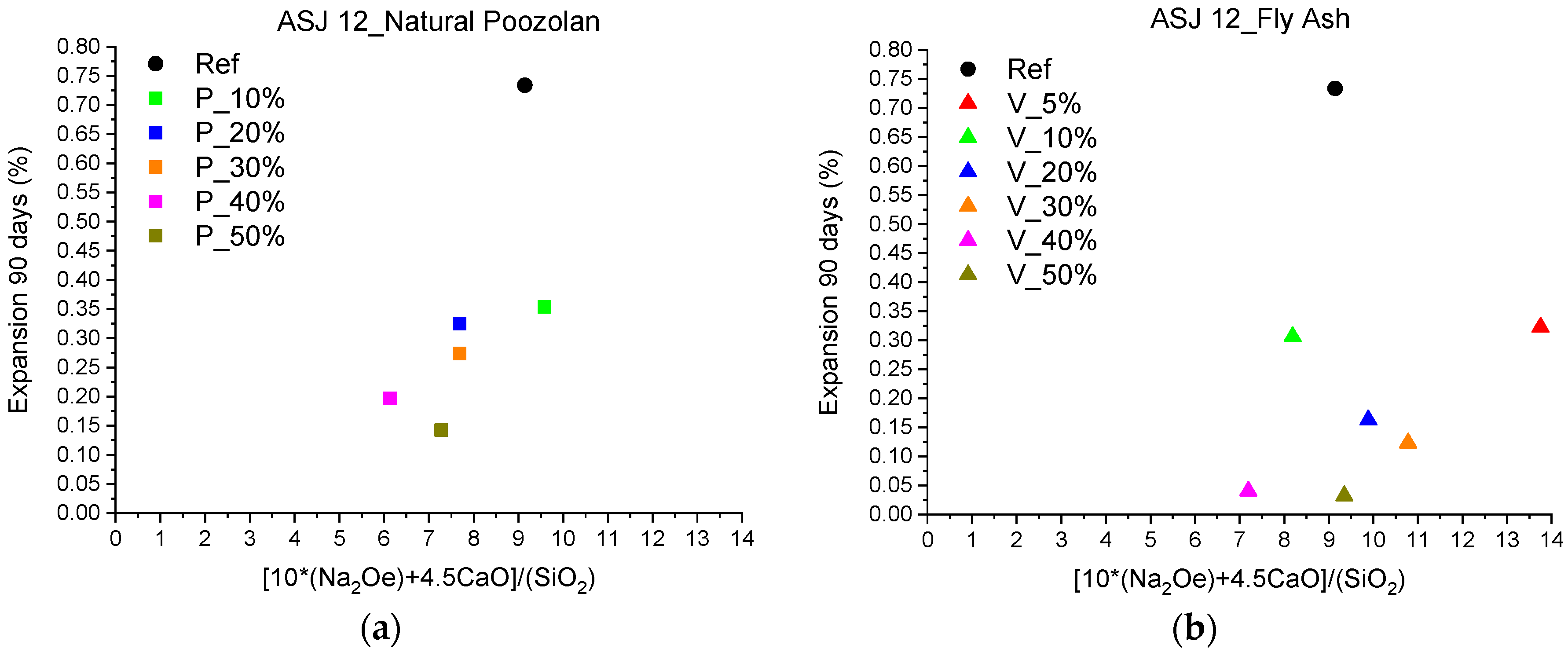

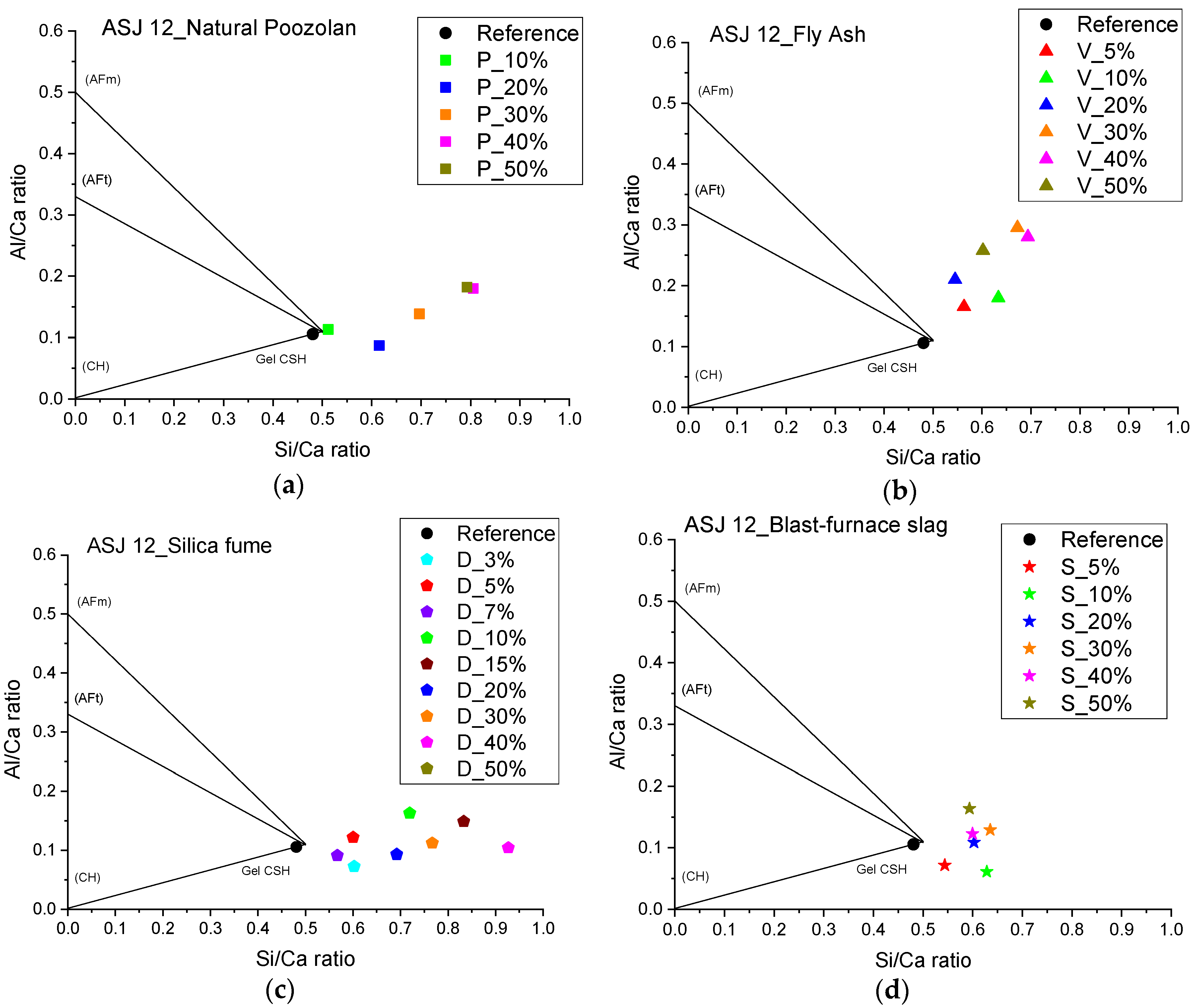
| Additive | Percentage of the Additive in the Blended Cement | ||||
|---|---|---|---|---|---|
| Silica fume, D | 3% | 5% | 7% | 10% | 15% |
| Siliceous coal fly ash, V | 5% | 10% | 20% | 30% | 40% |
| Ground granulated blast-furnace slag, S | 5% | 10% | 20% | 30% | 40% |
| Natural pozzolan, P | 10% | 20% | 30% | 40% | 50% |
| Parameter | CEM I 42.5 N | V | S | D | P |
|---|---|---|---|---|---|
| Al2O3 | 3.65 | 23.16 | 12.16 | - | 13.15 |
| CaO | 64.49 | 5.75 | 41.55 | 0.60 | 12.98 |
| Cl− | 0.03 | - | - | 0.06 | - |
| Cr2O3 | 0.02 | 0.17 | - | - | - |
| Fe2O3 | 3.96 | 5.93 | 0.39 | 0.14 | 12.75 |
| K2O | 0.64 | 0.96 | 0.48 | 3.03 | 0.56 |
| MgO | 1.27 | 1.96 | 6.96 | 0.33 | 9.62 |
| Mn2O3 | 0.05 | 13.35 | 48.97 | 40.06 | - |
| Na2O | 0.12 | 3.93 | 0.17 | 1.23 | 0.63 |
| P2O5 | 0.18 | 0.67 | - | - | 1.26 |
| SiO2 | 20.80 | 52.17 | 35.13 | 91.31 | 42.82 |
| SO3 | 2.33 | 0.36 | 1.86 | - | 0.00 |
| SrO | 0.06 | 0.10 | 0.05 | - | 0.12 |
| TiO2 | 0.19 | 0.92 | 0.56 | - | 3.62 |
| ZnO | 0.01 | 0.02 | - | - | 0.02 |
| ZrO2 | - | 0.03 | 0.02 | - | 0.05 |
| LOI 1 | 2.21 | 3.80 | 0.45 | 3.29 | 2.21 |
| Na2Oeq 1 | 0.54 | 4.56 | 0.49 | 3.22 | 0.99 |
| Parameter | ASJ-2 | VB-1 | ASJ-12 |
|---|---|---|---|
| SiO2 | 73.61 | 78.06 | 60.55 |
| Al2O3 | 6.48 | 3.64 | 15.80 |
| Fe2O3 | 0.88 | 1.28 | 6.83 |
| K2O | 4.02 | 0.66 | 4.58 |
| CaO | 9.25 | 9.82 | 4.30 |
| Na2O | 0.87 | 0.14 | 2.88 |
| MgO | 0.20 | 0.30 | 2.47 |
| TiO2 | 0.09 | 0.26 | 1.00 |
| P2O5 | 0.06 | 0.12 | 0.45 |
| BaO | 0.04 | - | 0.09 |
| MnO | 0.01 | 0.01 | 0.08 |
| Cr2O3 | 0.07 | 0.04 | 0.04 |
| SrO | 0.01 | - | 0.03 |
| ZrO2 | - | - | 0.03 |
| SO3 | 0.06 | 0.05 | 0.02 |
| Rb2O | 0.02 | - | 0.02 |
| Cl− | 0.01 | - | 0.02 |
| LOI 1 | 4.31 | 5.59 | 0.81 |
| Na2Oeq 1 | 3.51 | 0.58 | 5.89 |
| Main crystalline component | Quartz | Quartz | Quartz |
| Minority crystalline components | Feldspars (Albite type) Black mica (Biotite) | Feldspars (Microcline) Carbonates (Calcite) | Carbonates (Calcite type) |
Publisher’s Note: MDPI stays neutral with regard to jurisdictional claims in published maps and institutional affiliations. |
© 2020 by the authors. Licensee MDPI, Basel, Switzerland. This article is an open access article distributed under the terms and conditions of the Creative Commons Attribution (CC BY) license (http://creativecommons.org/licenses/by/4.0/).
Share and Cite
Menéndez, E.; Sanjuán, M.Á.; García-Roves, R.; Argiz, C.; Recino, H. Sustainable and Durable Performance of Pozzolanic Additions to Prevent Alkali-Silica Reaction (ASR) Promoted by Aggregates with Different Reaction Rates. Appl. Sci. 2020, 10, 9042. https://doi.org/10.3390/app10249042
Menéndez E, Sanjuán MÁ, García-Roves R, Argiz C, Recino H. Sustainable and Durable Performance of Pozzolanic Additions to Prevent Alkali-Silica Reaction (ASR) Promoted by Aggregates with Different Reaction Rates. Applied Sciences. 2020; 10(24):9042. https://doi.org/10.3390/app10249042
Chicago/Turabian StyleMenéndez, Esperanza, Miguel Ángel Sanjuán, Ricardo García-Roves, Cristina Argiz, and Hairon Recino. 2020. "Sustainable and Durable Performance of Pozzolanic Additions to Prevent Alkali-Silica Reaction (ASR) Promoted by Aggregates with Different Reaction Rates" Applied Sciences 10, no. 24: 9042. https://doi.org/10.3390/app10249042







